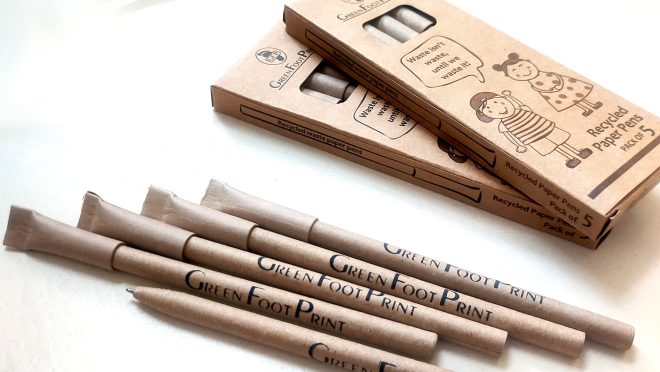Are recyclable pens worth it?
Are recyclable pens worth it?

Recently, I had the opportunity to use a recyclable pen, which is technically a standard ballpoint pen with ink, but its exterior is made of paper instead of plastic. What is so special about it, then?
Consider this: we students typically need approximately two to three pens every month, so in 12 months, we use at least twenty-four pens. These paper-made pens help reduce plastic waste, as ballpoint pens are not recyclable once the ink is depleted.
I think it was brilliant to come up with the idea of ‘paper-made’ pens; they not only avoid plastic waste but are also environmentally friendly. However, some of you are wondering that since it is made of paper, it will cut down trees to make the paper.
Well, there is another speciality about these recyclable pens: at the bottom end of them, there are sealed plant seeds, so a person can ‘reuse’ the pen by planting it in the soil.
This means that if anyone even throws it away, it will not end up in landfill sites; instead, the paper will eventually decompose, and the seeds will spread in the soil, indirectly planting new plants. So, there is a win-win situation, as no plastic waste is generated, and with trees being cut down, more trees are being planted through the paper pens that are thrown away.
How do these recyclable pens perform? Well, they are like regular ballpoint pens; the ink and feel are the same. Some may think the paper texture will make it rough, but in reality, it’s much smoother, and the grip is also good enough to write.
On the bright side, the paper pens are more comfortable since they aren’t rough and have no edges, unlike the plastic pens, so no marks are left behind on the fingers after a long period of writing.
Surprisingly, the pen also glides smoothly; if you’re accustomed to the Matador standard pen, it gives the same feel. However, it requires a little more pressure while writing, as the ink lightens slightly otherwise. Unlike my initial impression, the ink doesn’t leak, so it’s safe to say it is suitable for students’ use.
Therefore, paper-made pens can be a handy option if they are manufactured appropriately and are comfortable for regular use. If students find comfort in these, then plastic use will decrease, and more children will lean towards more environmentally friendly options. Moreover, with an increase in demand, more companies will also attempt to adopt this new idea to remain competitive in the market. The paper-made pens are a brilliant way to keep children aware of the environment and how they are contributing to its development from a young age.
If the paper-made pens project becomes successful, other projects can also take place, such as making recyclable pencils, rulers, and even erasers. It is a significant step for the children of Bangladesh to contribute to their environment in a helpful manner.


